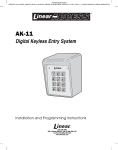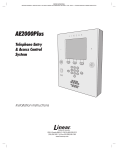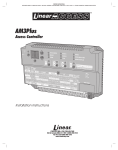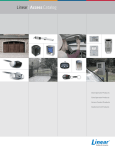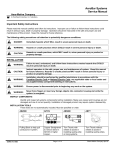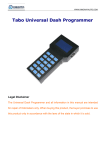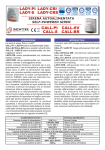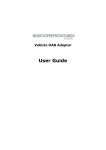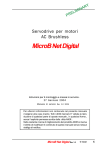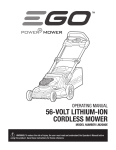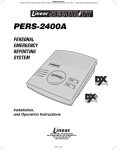Download Linear Telephone AE1000Plus User's Manual
Transcript
PRINTER’S INSTRUCTIONS: INSTR,ACCESS LOCAL PROGRAMMING - LINEAR P/N: 228505 A - INK: BLACK - MATERIAL: 20 LB. MEAD BOND - SIZE: 8.500” X 11.000” - SCALE: 1-1 - FOLDING: ALBUM-FOLD - BINDING: SADDLE-STITCH AE1000Plus AE2000Plus AM3Plus Local Programming Addendum USA & Canada (800) 421-1587 & (800) 392-0123 (760) 438-7000 - Toll Free FAX (800) 468-1340 www.linearcorp.com Table of Contents 1 Introduction . . . . . . . . . . . . . . . . . . . . . . . . . . . . . . . . . . . . . . . . . . . . . . . . . . . . . . . . . . . . . . . . . . . . . . . . . . . . . . . . . . . . 1 Important Local Programming Note for Network Installations . . . . . . . . . . . . . . . . . . . . . . . . . . . . . . . . . . . . . . . . . . . . . 1 2 Keypad Data Entry Keys . . . . . . . . . . . . . . . . . . . . . . . . . . . . . . . . . . . . . . . . . . . . . . . . . . . . . . . . . . . . . . . . . . . . . . . . . . 1 3 Entering Programming Mode . . . . . . . . . . . . . . . . . . . . . . . . . . . . . . . . . . . . . . . . . . . . . . . . . . . . . . . . . . . . . . . . . . . . . . 1 Programming Mode Time Out . . . . . . . . . . . . . . . . . . . . . . . . . . . . . . . . . . . . . . . . . . . . . . . . . . . . . . . . . . . . . . . . . . . . . 1 4 Visual Feedback . . . . . . . . . . . . . . . . . . . . . . . . . . . . . . . . . . . . . . . . . . . . . . . . . . . . . . . . . . . . . . . . . . . . . . . . . . . . . . . . . 2 5 Audible Feedback . . . . . . . . . . . . . . . . . . . . . . . . . . . . . . . . . . . . . . . . . . . . . . . . . . . . . . . . . . . . . . . . . . . . . . . . . . . . . . . . 2 6 Switching to Normal Network Operation Mode . . . . . . . . . . . . . . . . . . . . . . . . . . . . . . . . . . . . . . . . . . . . . . . . . . . . . . . . 2 AccessBase2000 System . . . . . . . . . . . . . . . . . . . . . . . . . . . . . . . . . . . . . . . . . . . . . . . . . . . . . . . . . . . . . . . . . . . . . . . . . 2 AXNET System . . . . . . . . . . . . . . . . . . . . . . . . . . . . . . . . . . . . . . . . . . . . . . . . . . . . . . . . . . . . . . . . . . . . . . . . . . . . . . . . 2 7 Re-enabling Local Programming . . . . . . . . . . . . . . . . . . . . . . . . . . . . . . . . . . . . . . . . . . . . . . . . . . . . . . . . . . . . . . . . . . . 2 8 Local Programming Functions . . . . . . . . . . . . . . . . . . . . . . . . . . . . . . . . . . . . . . . . . . . . . . . . . . . . . . . . . . . . . . . . . . . . . 3 Function 01: Change Master Password . . . . . . . . . . . . . . . . . . . . . . . . . . . . . . . . . . . . . . . . . . . . . . . . . . . . . . . . . . . . . 3 Function 02: Directory Code Length . . . . . . . . . . . . . . . . . . . . . . . . . . . . . . . . . . . . . . . . . . . . . . . . . . . . . . . . . . . . . . . 3 Function 05: Date & Time . . . . . . . . . . . . . . . . . . . . . . . . . . . . . . . . . . . . . . . . . . . . . . . . . . . . . . . . . . . . . . . . . . . . . . . . 3 Function 06: Time Zones . . . . . . . . . . . . . . . . . . . . . . . . . . . . . . . . . . . . . . . . . . . . . . . . . . . . . . . . . . . . . . . . . . . . . . . . 3 Function 20: PBX Dialing Digit . . . . . . . . . . . . . . . . . . . . . . . . . . . . . . . . . . . . . . . . . . . . . . . . . . . . . . . . . . . . . . . . . . . . 4 Function 21: Enter Directory Codes . . . . . . . . . . . . . . . . . . . . . . . . . . . . . . . . . . . . . . . . . . . . . . . . . . . . . . . . . . . . . . . . 4 Function 23: Delete Directory Code . . . . . . . . . . . . . . . . . . . . . . . . . . . . . . . . . . . . . . . . . . . . . . . . . . . . . . . . . . . . . . . . 4 Function 31: Enter Entry Codes . . . . . . . . . . . . . . . . . . . . . . . . . . . . . . . . . . . . . . . . . . . . . . . . . . . . . . . . . . . . . . . . . . . 5 Function 33: Delete Entry Codes . . . . . . . . . . . . . . . . . . . . . . . . . . . . . . . . . . . . . . . . . . . . . . . . . . . . . . . . . . . . . . . . . . 5 Function 41: Enter Cards & Transmitters . . . . . . . . . . . . . . . . . . . . . . . . . . . . . . . . . . . . . . . . . . . . . . . . . . . . . . . . . . . . 5 Function 42: Reactivate/Deactivate Card or Transmitter . . . . . . . . . . . . . . . . . . . . . . . . . . . . . . . . . . . . . . . . . . . . . . . . 5 Function 43: Delete Card or Transmitter Block . . . . . . . . . . . . . . . . . . . . . . . . . . . . . . . . . . . . . . . . . . . . . . . . . . . . . . . . 5 Function 44: Set Button Schedule . . . . . . . . . . . . . . . . . . . . . . . . . . . . . . . . . . . . . . . . . . . . . . . . . . . . . . . . . . . . . . . . . 6 Function 52: Configure Onboard Relays . . . . . . . . . . . . . . . . . . . . . . . . . . . . . . . . . . . . . . . . . . . . . . . . . . . . . . . . . . . . 6 Function 55: Enter Obstacle Transmitters . . . . . . . . . . . . . . . . . . . . . . . . . . . . . . . . . . . . . . . . . . . . . . . . . . . . . . . . . . . 6 Function 56: Delete Obstacle Transmitters. . . . . . . . . . . . . . . . . . . . . . . . . . . . . . . . . . . . . . . . . . . . . . . . . . . . . . . . . . . 6 Function 57: Welcome Display Text . . . . . . . . . . . . . . . . . . . . . . . . . . . . . . . . . . . . . . . . . . . . . . . . . . . . . . . . . . . . . . . . 7 Function 64: Set Talk Time . . . . . . . . . . . . . . . . . . . . . . . . . . . . . . . . . . . . . . . . . . . . . . . . . . . . . . . . . . . . . . . . . . . . . . . 7 Function 65: Configure Remote Devices . . . . . . . . . . . . . . . . . . . . . . . . . . . . . . . . . . . . . . . . . . . . . . . . . . . . . . . . . . . . 7 Function 67: Postal Key Door . . . . . . . . . . . . . . . . . . . . . . . . . . . . . . . . . . . . . . . . . . . . . . . . . . . . . . . . . . . . . . . . . . . . . 7 Function 99: Exit Programming Mode . . . . . . . . . . . . . . . . . . . . . . . . . . . . . . . . . . . . . . . . . . . . . . . . . . . . . . . . . . . . . . 7 9 Programming Worksheet . . . . . . . . . . . . . . . . . . . . . . . . . . . . . . . . . . . . . . . . . . . . . . . . . . . . . . . . . . . . . . . . . . . . . . . . . . 8 STATUS/PROGRAM DISPLAY "UP" BUTTON "DOWN" BUTTON STATUS/PROGRAM DISPLAY SYSTEM RESTART BUTTON "ENTER" BUTTON "UP" BUTTON "DOWN" BUTTON RELAY "A" LATCH AE1000PLUS OR AE2000PLUS MAIN CIRCUIT BOARD RELAY "B" LATCH RELAY "C" LATCH RELAY "D" LATCH AE1000Plus and AE2000Plus Controller Buttons "ENTER" BUTTON RELAY "A" LATCH RELAY "B" LATCH RELAY "C" LATCH AM3Plus Controller Buttons RELAY "D" LATCH 1 Introduction Linear has added a local programming option for the AE1000Plus, AE2000Plus, and AM3Plus access control panels. Local programming is suitable for the system installers during the early stages of new building construction projects where a computer is not accessible for programming or when telephone lines are not yet available for connecting to the panels. Local programming allows for the setting of commonly programmed options directly from the panel keypad for the AE1000Plus and AE2000Plus units, and from an attached PBUS keypad (AM-KP or AM-KPI, configured at address DV1) for the AM3Plus units. Local programming requires that each panel in the installation be programmed separately, regardless of whether the panels are physically connected in a network configuration. Local programming can be used as a primary means of maintaining the panel as long as a PC is not used to connect to the installation. Upon an initial database update using AccessBase2000 or an initial PPP connection to the primary node in AXNET, the existing local programming information will be erased from the panels in the installation. It is highly recommended to use the worksheet provided in the back of this addendum to log locally programmed installation information in detail for record keeping or as a reference when the locally programmed units are switched over to PC programming. 2 Keypad Data Entry Keys The keypads have the ten number keys. AE1000Plus and AM3Plus (with a remote keypad) have also an asterisk “∗” and pound key “#”. For AE2000Plus, the key functions as the asterisk “∗” and the key functions as the pound “#” key. Generally, the asterisk is used to clear entry mistakes, and the pound key is used to signal the end of a field entry. During entry of a numeric field, if the field is not empty, the “∗” will clear the entry of the entire field. If the field is empty, the “∗” will take the user interface to the command entry level. During entry of an alphanumeric field, if the field is not empty, the “∗” will clear the entries of the characters one at a time. If the field is empty, the “∗” will take the user interface to the command entry level. 3 Entering Programming Mode The controller database must be cleared before initial local programming can be performed. Setup Mode is entered by pressing the UP and DOWN buttons simultaneously for about one second. Scroll using the DOWN button to CL, then press ENTER. On the AE1000Plus and AE2000Plus systems, enter Programming Mode by pressing the “0” and “2” keys simultaneously, followed by the system password (default 123456), then enter a “#”. On the AM3Plus systems, enter Programming Mode by entering three pound signs (###), the system password (default 123456), followed by a “#”. Programming Mode Time Out If a correct master password is not entered within 10 seconds after the user attempts to enter Local Programming mode, the system will return to normal operation mode. During Local Programming mode, if the keypad is idle for more than two minutes, the system will return to normal operation mode. 1 4 Visual Feedback On the AE2000Plus and AE1000Plus systems, a text prompt will be shown on the system display for guidance. On the AM3Plus system, the LED on the PBUS keypad will be used to provide visual feedback. A long “amber” LED will signify an error, two short flashing green LED will signify the successful entry of a programming field, and three short flashing green LED will signify the successful entry of a complete programming step. 5 Audible Feedback When entering data, one long beep will signify an error, two short beeps will signify the successful entry of a programming field, and three short beeps will signify the successful entry of a complete programming step. One short beep will signify the entry of the asterisk “∗” key. 6 Switching to Normal Network Operation Mode In Local Programming mode, each Controller operates individually in a non-network configuration. In order for the installer to be able to remotely switch the installation back to normal network operation mode, each unit needs to have the node address set correctly and the network cables wired during Local Programming mode. AccessBase2000 System For AccessBase2000 configuration, when the installer presses the “ON/OFF-line with installation” button from AccessBase 2000 application, AccessBase 2000 application will be able to detect all nodes that are connected to the network. After the installation is connected, the database that was entered while in Local Programming mode will not be erased and Local Programming will still be enabled. This feature maybe used by the installer to verify that the network cabling is correct without erasing the locally programmed database. When the “Program network” button is pressed, the locally programmed database will be erased and Local Programming will be disabled. AXNET System For AXNET configuration, when the installer remotely connects to the master node via a PPP connection, the master node’s database that was entered via Local Programming will be erased and Local Programming will be disabled. After the master node’s database is erased and initialized, it needs to be configured with the network connection topology. This can be done by using a Web Browser connected to the master node with URL http://192.6.94.2; then setup the correct network topology via Global Settings -> Networking and select the correct Network Topology Configuration. As an example, if Network Topology 2 is selected, Node 2’s database that was entered via Local Programming will be erased and its Local Programming will be disabled. The browser will display a dialog box indicating that “Node 2 is now Inaccessible”. Inaccessible nodes can only be reactivated by resubmitting previous commands via the Network Status menu. The installer will need to acknowledge this message and then go to Controllers -> My Controller 2 and click the Refresh button to refresh Node 2’s status and regain the accessibility to Node 2. If the PPP connection to the master node is via a modem, the installer will need to disconnect the PPP connection to the master node so that the master node can use the phone line to connect to the other nodes on the network. 7 Re-enabling Local Programming Local Programming may be re-enabled when Data Flash is erased by using UP & DOWN switches on the motherboard to select and activate CL option (see Page 1). 2 8 Local Programming Functions Function 01: Change Master Password The master password is used to protect the database that was entered via local programming. The master password can be changed using this function. Default password “123456” still should be used (instead of the changed Master Password) when AB2000 or AXNET connection is used to connect to the controller. CHANGE MASTER PASSWORD FCN 01 01#PW#PW# PW = NEW 6-DIGIT PASSWORD FACTORY SETTING: 123456 Function 02: Directory Code Length (AE1000Plus and AE2000Plus Only) The factory settings sets the Directory Code Length at 3 digits. The length of the Directory Code can be changed from 2 to 4 digits using this function. FCN 02 SET DIRECTORY CODE LENGTH 02#LENGTH# LENGTH = 2 TO 4 DIGITS FACTORY SETTING: 3 DIGITS Function 05: Date & Time SET DATE AND TIME Using this function, the date and time can be entered. It should be the Controller’s current local date and time regardless if Daylight Saving Time is currently being observed at the Controller’s location. 05#YEAR#MONTH#DAY#HOUR#MINUTE#DST# At the prompt of the DST field, the Controller will display “ENABLED” on the second line if the previous DST setting is enabled; and “DISABLED” if the previous setting is disabled. YEAR = 2000 - 2127 MONTH = 1 - 12 DAY = 1 - 31 FCN 05 HOUR = 0 - 23 (LOCAL TIME) MINUTE = 0 - 59 DST = 1 FOR ENA; 0 FOR DIS Enter a “1” to enable DST or a “0” to disable DST if the setting is to be changed. If the DST value will not be changed, enter # to accept the displayed value. If the Controller will observe DST, then regardless whether the current local time is in DST or not, the DST field should always be entered as a “1”. For example, suppose that current date is January 20, 2008 and local time is 10:00 AM and the Controller will observe DST, even though the current time is not in DST, the installer should enter January 20, 2008 as the date, 10:00 as the time and 1 for DST field. The panel will have a default value of “DST Enabled” when Local Programming mode is first enabled. Function 06: Time Zones Two time zones utilizing two time periods each are programmable with this function. Holidays are not included. The entry of the first period is required. The entry for the second period of the time zone is optional. To skip it, enter a “#” key at the prompt for the second period to end the Time Zone function code entry. When entering days of the week, enter all the active days. Monday =1 Tuesday = 2 Wednesday = 3 Thursday = 4 Friday = 5 Saturday = 6 Sunday = 7 SET TIME ZONES FCN 06 06#TZ NUM#ACT DAY# ST HR1#ST MN1#EN HR1#EN MN1# ST HR2#ST MN2#EN HR2#EN MN2# TZ NUM = TIME ZONE NUMBER 1 OR 2 ACT DAY = ENTER ALL ACTIVE DAYS MON-SUN = 1-7 ST HR1 = START HOUR #1, ENTER 0-23 ST MN1 = START MINUTE #1, ENTER 0-59 EN HR1 = END HOUR #1, ENTER 0-23 EN MN1 = END MINUTE #1, ENTER 0-59 ST HR2 = START HOUR #2, ENTER 0-23 ST MN2 = START MINUTE #2, ENTER 0-59 EN HR2 = END HOUR #2, ENTER 0-23 EN MN2 = END MINUTE #2, ENTER 0-59 3 8 Local Programming Functions (Continued) Function 20: PBX Dialing Digit PBX DIALING DIGIT (AE1000Plus and AE2000Plus Only) A PBX Dialing Digit can be programmed using this function (the default is none). This digit plus a four second delay will be added before the telephone number being dialed. Entering 10 removes the PBX Dialing Digit. FCN 20 20#VALUE# VALUE = DIALING DIGIT 0 - 9 10 = NONE FACTORY SETTING: NONE Function 21: Enter Directory Codes (AE1000Plus and AE2000Plus Only) Directory codes can be entered using this function. If the directory code entered already exists in the database, the firmware will reject the code and provide an error beep feedback. To enter the name information, the keypad is defined for the various alphabetic entries shown in the diagram to the right. The first time the key is pressed, the first letter is selected. Each press afterward will select the next letter. On the fourth press of the same key, the number will be selected. When the required value is reached, press another key for another letter, or wait three seconds (a beep will sound) to advance to the next letter. ENTER DIRECTORY CODES FCN 21 21#DIR CODE#LAST#FIRST#PHONE# DIR CODE = DIRECTORY CODE TO SET LAST = RESIDENT'S LAST NAME FIRST = RESIDENT'S FIRST NAME PHONE = RESIDENT'S PHONE NUMBER KEYPAD ALPHANUMERIC ENTRY (FOR PROGRAMMING STEPS REQUIRING TEXT) abc The first letter of each word will be capitalized. To capitalize all of the letters entered, begin with the “#” key. def ghi mno jkl pqr stu yz, backspace or erase entire line finish entry vwx space, minus sign, dot Function 23: Delete Directory Code (AE1000Plus & AE2000Plus Only) Directory codes can be deleted using this function. For the AE1000Plus and AE2000Plus, enter the directory code to be deleted. The first line will show “Code: xxx” where “xxx” is the code entered. The second line will display the tenant’s name. Enter the code the second time to delete the code. 4 DELETE DIRECTORY CODE FCN 23 23#CODE#CODE# CODE = THE RESIDENT'S DIRECTORY CODE TO DELETE 8 Local Programming Functions (Continued) Function 31: Enter Entry Codes Entry Codes can be added using this function. In AccessBase2000 system, Entry Codes may have variable length from one to eight digits. However, in Local Programming mode, the length of Entry Code is fixed at four digits. ENTER ENTRY CODES FCN 31 31#CODE#CODE# CODE = THE FOUR-DIGIT ENTRY CODE TO ADD Function 33: Delete Entry Codes Entry codes can be deleted from the Controller using this function. DELETE ENTRY CODES FCN 33 33#CODE#CODE# CODE = THE ENTRY CODE TO DELETE Function 41: Enter Cards & Transmitters This function enters block coded cards or transmitters only. The Start ID and the End ID cannot be the same. Each block must have a minimum of two cards or transmitters. The length of the block’s start and stop ID number allowed depends on the programming software used. AccessBase2000 allows a maximum of 13 digits up to 1099511627775. AXNET allows a maximum of 5 digits up to 65535. All cards and transmitters are active when entered in local programming. Function 42: Reactivate/Deactivate Card or Transmitter The cards and transmitters may be deactivated or reactivated using this function. The cards and transmitters are active when allocated. Function 43: Delete Card or Transmitter Block Card and transmitter blocks can be deleted from the Controller using this function. The function will remove an entire block from the Controller. ENTER CARDS AND TRANSMITTERS FCN 41 41#TYPE#BLOCK#FC#SID#EID# TYPE = 1 FOR CARDS; 2 FOR TRANSMITTERS BLOCK = BLOCK NUMBER (# TO ACCEPT OR CHANGE) FC = FACILITY CODE (CARDS 1-255; TRANSMITTERS 0-15) SID = STARTING BLOCK ID NUMBER EID = ENDING BLOCK ID NUMBER REACTIVATE OR DEACTIVATE CARD OR TRANSMITTER FCN 42 42#TYPE#FC#ID#ACTION# TYPE = 1 FOR CARDS; 2 FOR TRANSMITTERS FC = FACILITY CODE (CARDS 1-255; TRANSMITTERS 0-15) ID = ID NUMBER OF CARD OR TRANSMITTER ACTION = 0 TO DEACTIVATE; 1 TO ACTIVATE DELETE CARD OR TRANSMITTER BLOCK FCN 43 43#TYPE#BLOCK# TYPE = 1 FOR CARDS; 2 FOR TRANSMITTERS BLOCK = BLOCK NUMBER 1-24 5 8 Local Programming Functions (Continued) Function 44: Set Button Schedule Access relays can be programmed to activate from a specific button on multi-button transmitters. Use this function to assign a button for each relay. Enter the button position number (0-8) for each relay. Enter # for any relay that will not have a transmitter button assigned. Function 52: Configure Onboard Relays Access relays can be programmed to activate for different lengths of time; be set for pulse, toggle, or latch; and set to stay latched during a selected time zone. Use this function to configure each relay. SET BUTTON SCHEDULE FCN 44 44#RLY-A#RLY-B#RLY-C#RLY-D# RLY A = RELAY A BUTTON RLY B = RELAY B BUTTON RLY C = RELAY C BUTTON RLY D = RELAY D BUTTON 0 = NONE 1 = ANY 2 = LEFT 3 = RIGHT 4 = TOP 5 = TOP LEFT 6 = TOP RIGHT 7 = BOTTOM LEFT 8 = BOTTOM RIGHT CONFIGURE ONBOARD RELAYS FCN 52 52#CH#TIMING#OPERATION#TZ1#TZ2#TIME# CH = 1 FOR RLY A; 2 FOR RLY B; 3 FOR RLY C; 4 FOR RLY D TIMING = 1 FOR ACTIVATION TIME 2 FOR 1/4 SECOND PULSE ACTIVATION 3 FOR TOGGLE ON-OFF, OFF-ON 4 FOR LATCH OPERATION = 1 FOR CONTROL; 4 FOR OBSTACLE TZ1 = TIME ZONE NUMBER FOR RELAY HELD ON (# TO SKIP) TZ2 = TIME ZONE NUMBER FOR RELAY HELD ON (# TO SKIP) (SKIP TZ1 & TZ2 FOR OBSTACLE TRANSMITTERS) TIME = ACTIVE TIME IN SECONDS (ONLY FOR MODE 1) Function 55: Enter Obstacle Transmitters One or two Model MGT Gate Safety Edge Transmitters can be programmed into the Controller. Each obstacle transmitter can be programmed to trigger Relay Channel C or Relay Channel D. Use this function to enter obstacle transmitters into memory. Function 56: Delete Obstacle Transmitters Obstacle transmitters can be deleted from the Controller using this function. The function will remove one transmitter at a time. ENTER OBSTACLE TRANSMITTERS FCN 55 55#RLY#FC#ID# RLY = 1 FOR RELAY C; 2 FOR RELAY D FC = FACILITY CODE 0-15 ID = TRANSMITTER ID 0-65535 DELETE OBSTACLE TRANSMITTERS FCN 56 56#TX NUM# TX NUM = 1 FOR RELAY C TRANSMITTER 2 FOR RELAY D TRANSMITTER 6 8 Local Programming Functions (Continued) Function 57: Welcome Display Text The welcome text displayed by the Controller can be modified using this function. Refer to the keypad alphanumeric key figure shown on Page 4 for keypad details. EDIT WELCOME DISPLAY TEXT FCN 57 57#LINE 1#LINE 2# LINE 1 = TEXT FOR FIRST LINE OF THE DISPLAY LINE 2 = TEXT FOR THE SECOND LINE OF THE DISPLAY Function 64: Set Talk Time (AE1000Plus and AE200Plus Only) The length of time allowed for the Visitor to talk with the Resident can be adjusted using this function (the default time is 60 seconds). The Talk Time can be extended during the call by the Resident by pressing the pound (#) telephone key. Function 65: Configure Remote Devices Remote devices can be configured for type, device number, and the relay that the device will activate. Use this function to configure remote devices. NOTE: AM3Plus panels will not accept Type 7 devices. Do not change the device type from “Remote Keypad” on Device #1 to any other device type. Doing so will result in loss of local programming control, and will require clearing of the panel. Clearing of the panel will result in the loss of any existing programming information. Function 67: Postal Key Door The relay channel that the postal lock key will activate can be programmed using this function (the default is Channel A). The postal lock can be programmed to activate Relay Channel A, B, C, or D. SET TALK TIME FCN 64 64#TIME# TIME = TALK TIME IN SECONDS CONFIGURE REMOTE DEVICES FCN 65 65#DEVICE#TYPE#CHANNEL# DEVICE = DEVICE NUMBER (AccessBase 1-9, AxNet 1-4, 7, 8 or 9) TYPE = DEVICE TYPE NUMBER (SEE BELOW) CHANNEL = 1-4 FOR RELAY A-D; 5 FOR BUTTONS TYPE 0 = NONE TYPE 1 = REMOTE KEYPAD TYPE 2 = RADIO TYPE 3 = WIEGAND26 CARD READER TYPE 4 = WIEGAND30 CARD READER TYPE 5 = WIEGAND31 CARD READER TYPE 7 = TELEPHONE INTERFACE (ALWAYS DV7) POSTAL KEY DOOR FCN 67 67#RELAY# RELAY = 1 FOR RELAY CHANNEL A 2 FOR RELAY CHANNEL B 3 FOR RELAY CHANNEL C 4 FOR RELAY CHANNEL D Function 99: Exit Programming Mode EXIT PROGRAMMING MODE FCN 99 Use this function to exit programming mode. 99# 7 9 Programming Worksheet FCN # USAGE FACTORY DEFAULT CUSTOM SETTING 01 CHANGE MASTER PASSWORD 123456 __________ MASTER PASSWORD (6-DIGITS) 02 DIRECTORY NUMBER LENGTH 3 DIGITS _____ DIGITS (1-4 DIGITS) 20 PBX DIALING DIGIT NONE _____ (0-9, 10 = NONE) 64 MAXIMUM VISITOR TALK TIME 60 SECONDS _____ SECONDS (15-255 SECONDS) 67 POSTAL KEY RELAY CHANNEL RELAY A ❑ RELAY “A” ❑ RELAY “B” ❑ RELAY “C” ❑ RELAY “D” FUNCTION 06 TIME ZONES TIME ZONE # ACTIVE DAYS 1ST START HR/MIN 1ST END HR/MIN 2ND START HR/MIN 2ND END HR/MIN TZ 1 ❑ MON ❑ TUE ❑ WED ❑ THU ❑ FRI ❑ SAT ❑ SUN ___ (0-23) ___ (0-59) ___ (0-23) ___ (0-59) ___ (0-23) ___ (0-59) ___ (0-23) ___ (0-59) TZ 2 ❑ MON ❑ TUE ❑ WED ❑ THU ❑ FRI ❑ SAT ❑ SUN ___ (0-23) ___ (0-59) ___ (0-23) ___ (0-59) ___ (0-23) ___ (0-59) ___ (0-23) ___ (0-59) FUNCTION 41 BLOCK # FACILITY CODE CARD #1 ENROLL BLOCK CARDS START BLOCK ID # FUNCTION 41 END BLOCK ID # ENROLL BLOCK TRANSMITTERS BLOCK # FACILITY CODE ____ (1-255) TRANS #1 ____ (0-15) CARD #2 ____ (1-255) TRANS #2 ____ (0-15) CARD #3 ____ (1-255) TRANS #3 ____ (0-15) CARD #4 ____ (1-255) TRANS #4 ____ (0-15) CARD #5 ____ (1-255) TRANS #5 ____ (0-15) CARD #6 ____ (1-255) TRANS #6 ____ (0-15) CARD #7 ____ (1-255) TRANS #7 ____ (0-15) CARD #8 ____ (1-255) TRANS #8 ____ (0-15) CARD #9 ____ (1-255) TRANS #9 ____ (0-15) CARD #10 ____ (1-255) TRANS #10 ____ (0-15) CARD #11 ____ (1-255) TRANS #11 ____ (0-15) CARD #12 ____ (1-255) TRANS #12 ____ (0-15) CARD #13 ____ (1-255) TRANS #13 ____ (0-15) CARD #14 ____ (1-255) TRANS #14 ____ (0-15) CARD #15 ____ (1-255) TRANS #15 ____ (0-15) CARD #16 ____ (1-255) TRANS #16 ____ (0-15) CARD #17 ____ (1-255) TRANS #17 ____ (0-15) CARD #18 ____ (1-255) TRANS #18 ____ (0-15) CARD #19 ____ (1-255) TRANS #19 ____ (0-15) CARD #20 ____ (1-255) TRANS #20 ____ (0-15) CARD #21 ____ (1-255) TRANS #21 ____ (0-15) CARD #22 ____ (1-255) TRANS #22 ____ (0-15) CARD #23 ____ (1-255) TRANS #23 ____ (0-15) CARD #24 ____ (1-255) TRANS #24 ____ (0-15) START BLOCK ID # END BLOCK ID # FUNCTION 44 BUTTON SCHEDULES FOR RELAYS RELAY ACTIVATION BUTTON CHANNEL A ❑ NONE (0) ❑ ANY (1) ❑ LEFT (2) ❑ RIGHT (3) ❑ TOP (4) ❑ TOP LEFT (5) ❑ TOP RIGHT (6) ❑ BOTTOM LEFT (7) ❑ BOTTOM RIGHT (8) CHANNEL B ❑ NONE (0) ❑ ANY (1) ❑ LEFT (2) ❑ RIGHT (3) ❑ TOP (4) ❑ TOP LEFT (5) ❑ TOP RIGHT (6) ❑ BOTTOM LEFT (7) ❑ BOTTOM RIGHT (8) CHANNEL C ❑ NONE (0) ❑ ANY (1) ❑ LEFT (2) ❑ RIGHT (3) ❑ TOP (4) ❑ TOP LEFT (5) ❑ TOP RIGHT (6) ❑ BOTTOM LEFT (7) ❑ BOTTOM RIGHT (8) CHANNEL D ❑ NONE (0) ❑ ANY (1) ❑ LEFT (2) ❑ RIGHT (3) ❑ TOP (4) ❑ TOP LEFT (5) ❑ TOP RIGHT (6) ❑ BOTTOM LEFT (7) ❑ BOTTOM RIGHT (8) FUNCTION 52 RELAY SETUP RELAY RELAY MODE RELAY OPERATION CHANNEL A ❑ TIMED (1) ❑ PULSE (2) ❑ TOGGLE (3) ❑ LATCH (4) ❑ CONTROL (1) ❑ OBSTACLE (4) ____ (1-2) ____ (1-2) ____ (SECONDS) CHANNEL B ❑ TIMED (1) ❑ PULSE (2) ❑ TOGGLE (3) ❑ LATCH (4) ❑ CONTROL (1) ❑ OBSTACLE (4) ____ (1-2) ____ (1-2) ____ (SECONDS) CHANNEL C ❑ TIMED (1) ❑ PULSE (2) ❑ TOGGLE (3) ❑ LATCH (4) ❑ CONTROL (1) ❑ OBSTACLE (4) ____ (1-2) ____ (1-2) ____ (SECONDS) CHANNEL D ❑ TIMED (1) ❑ PULSE (2) ❑ TOGGLE (3) ❑ LATCH (4) ❑ CONTROL (1) ❑ OBSTACLE (4) ____ (1-2) ____ (1-2) ____ (SECONDS) 8 TIME ZONE 1 TIME ZONE 2 ACTIVATION TIME FUNCTION 65 REMOTE DEVICE SETUP DEVICE # DEVICE TYPE DEVICE #1 ❑ NONE (0) ❑ REMOTE KEYPAD (1) ❑ RADIO (2) ❑ WIEGAND26 (3) ❑ WIEGAND30 (4) ❑ WEIGAND31 (5) ❑ TELEPHONE INTERFACE (7) ❑ RELAY A (1) ❑ RELAY B (2) ❑ RELAY C (3) ❑ RELAY D (4) ❑ BUTTONS(5) DEVICE #2 ❑ NONE (0) ❑ REMOTE KEYPAD (1) ❑ RADIO (2) ❑ WIEGAND26 (3) ❑ WIEGAND30 (4) ❑ WEIGAND31 (5) ❑ TELEPHONE INTERFACE (7) ❑ RELAY A (1) ❑ RELAY B (2) ❑ RELAY C (3) ❑ RELAY D (4) ❑ BUTTONS(5) DEVICE #3 ❑ NONE (0) ❑ REMOTE KEYPAD (1) ❑ RADIO (2) ❑ WIEGAND26 (3) ❑ WIEGAND30 (4) ❑ WEIGAND31 (5) ❑ TELEPHONE INTERFACE (7) ❑ RELAY A (1) ❑ RELAY B (2) ❑ RELAY C (3) ❑ RELAY D (4) ❑ BUTTONS(5) DEVICE #4 ❑ NONE (0) ❑ REMOTE KEYPAD (1) ❑ RADIO (2) ❑ WIEGAND26 (3) ❑ WIEGAND30 (4) ❑ WEIGAND31 (5) ❑ TELEPHONE INTERFACE (7) ❑ RELAY A (1) ❑ RELAY B (2) ❑ RELAY C (3) ❑ RELAY D (4) ❑ BUTTONS(5) DEVICE #5 ❑ NONE (0) ❑ REMOTE KEYPAD (1) ❑ RADIO (2) ❑ WIEGAND26 (3) ❑ WIEGAND30 (4) ❑ WEIGAND31 (5) ❑ TELEPHONE INTERFACE (7) ❑ RELAY A (1) ❑ RELAY B (2) ❑ RELAY C (3) ❑ RELAY D (4) ❑ BUTTONS(5) DEVICE #6 ❑ NONE (0) ❑ REMOTE KEYPAD (1) ❑ RADIO (2) ❑ WIEGAND26 (3) ❑ WIEGAND30 (4) ❑ WEIGAND31 (5) ❑ TELEPHONE INTERFACE (7) ❑ RELAY A (1) ❑ RELAY B (2) ❑ RELAY C (3) ❑ RELAY D (4) ❑ BUTTONS(5) DEVICE #7 ❑ NONE (0) ❑ REMOTE KEYPAD (1) ❑ RADIO (2) ❑ WIEGAND26 (3) ❑ WIEGAND30 (4) ❑ WEIGAND31 (5) ❑ TELEPHONE INTERFACE (7) ❑ RELAY A (1) ❑ RELAY B (2) ❑ RELAY C (3) ❑ RELAY D (4) ❑ BUTTONS(5) DEVICE #8 ❑ NONE (0) ❑ REMOTE KEYPAD (1) ❑ RADIO (2) ❑ WIEGAND26 (3) ❑ WIEGAND30 (4) ❑ WEIGAND31 (5) ❑ TELEPHONE INTERFACE (7) ❑ RELAY A (1) ❑ RELAY B (2) ❑ RELAY C (3) ❑ RELAY D (4) ❑ BUTTONS(5) DEVICE #9 ❑ NONE (0) ❑ REMOTE KEYPAD (1) ❑ RADIO (2) ❑ WIEGAND26 (3) ❑ WIEGAND30 (4) ❑ WEIGAND31 (5) ❑ TELEPHONE INTERFACE (7) ❑ RELAY A (1) ❑ RELAY B (2) ❑ RELAY C (3) ❑ RELAY D (4) ❑ BUTTONS(5) DIR CODE RESIDENT NAME RESIDENT PHONE NUMBER ACTIVATION OUTPUT ENTRY CODE #1 ENTRY CODE #2 ENTRY CODE #3 9 Copyright © 2008 Linear LLC 228505 A












